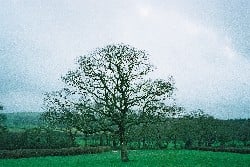CHOOSING NEW TREES
Give trees enough space
The trees you plant will probably outlive you, so it’s worth choosing carefully what you plant and where.
 | The main constraint in most gardens is lack of space. Always remember that trees grow! Don’t make the mistake of thinking that you can stop a tree from growing. Whatever you are planting, find out how big it may get, and plant it where it will have enough room to grow, so that you won’t need to have it pruned. |
Avoiding direct damage
- Buildings - don’t plant trees close enough to overhang buildings;
- Boundary walls - plant 2 m or more away;
- Power lines - don’t plant trees anywhere they could grow big enough to touch them, as they can be very dangerous;
- Telephone wires - try to avoid overhead lines;
- Leaking drains - get any leaks repaired before you plant (roots cannot get into sound, unbroken drains);
- Paving - tree roots can lift or crack lightweight things like slabs and blocks (they can’t directly lift heavy things like houses!) - plant trees at least 2-3 m away, or use something loose and permeable like gravel.
Avoiding indirect damage (subsidence)
The risk of subsidence depends on the interaction between soil, foundations, weather, and vegetation. Trees can increase the risk because of the water they take up from the soil. Ask a tree consultant and building surveyor or structural engineer for advice before planting trees close to buildings on clay soils.
Coppicing (cutting trees to ground level on a regular cycle, usually in woods) was traditionally used to produce poles for building and fuel. In gardens, coppicing can be useful to stabilise steep slopes, and may also have wildlife benefits.
Native trees
Native trees are wildlife, if given the chance to get there by themselves (usually helped by wind or birds), and they are usually better than exotic trees as habitats for other wildlife.
Not all native trees are suitable for planting in gardens. Don’t plant rare species - you will make their natural distribution pattern meaningless!
To let trees plant themselves, leave part of your garden unmown and undug, and see what comes up (this will usually depend on what trees are nearby, including non-native trees). Then choose what you want to keep and what to remove. Naturally self-set trees are usually more wind-firm than planted trees, and self-set woods are usually better for wildlife than plantations.
If you want to get trees in more quickly, or in a more planned way, you can plant them. Either grow your own from local trees, or buy your trees from a nursery which can guarantee local provenance. This means that trees have been propagated from the region they are to be planted back in and so are genetically local trees. This means they will be suited to the local conditions and other wildlife will be adapted to them. If you cannot get trees of local provenance, do not plant native trees - they will in effect be exotics and planting them may upset the local ecology.
Some of the species which may be suitable, depending on space, soil, aspect, and so on, include:
| Common Name | Latin Name |
| | |
| oak (pedunculate) | Quercus robur |
| ash | Fraxinus excelsior |
| wych elm | Ulmus glabra |
| birch (silver) | Betula pendula |
| holly | Ilex aquifolium |
| hedgerow hawthorn | Crataegus monogyna |
| bullace | Prunus domestica |
| alder | Alnus glutinosa |
| osier | Salix viminalis |
| oak (sessile) | Quercus petraea |
| English elm | Ulmus procera |
| cherry | Prunus avium |
| birch (downy) | Betula pubescens |
| maple | Acer campestre |
| blackthorn | Prunus spinosa |
| hazel | Corylus avellana |
| aspen | Populus tremula |
The Postcode Plants Database can tell you more about native plants in your area. For more information see Trees and Wildlife.
Exotic trees
| Native species are not the only suitable trees for gardens - exotic trees from beyond Britain can give all sorts of other possibilities of shape and texture, colour, taste and smell and be good for wildlife, if they provide shelter or food such as fruit and nuts. The Isle of Wight is probably one of the best places in Britain for growing plants - almost the only limitation, especially near the sea, is salt-laden winds. So don’t be restricted in your choice - there are thousands of different tree species around the world. Many are already growing here, and there are probably many more that could flourish. Get inspiration from books, nursery catalogues, TV, and visits to other gardens and parks. Choose trees which will be adapted to the conditions in your garden, including soil type, aspect, windiness, exposure to salt spray. See globaltrees for information about endangered exotics. |  |
Trees with a purpose
You may want trees just because they are beautiful, but you can also get fruit, nuts, timber, craft materials, and fuel from many species as well.
Buying trees
Garden centres usually only have a small stock of trees, so you may have more choice if you order trees from nurseries directly - many nurseries send plants by mail order. See the Royal Horticultural Society’s Plant Finder Buy young trees - they’re more vigorous than older trees and will recover faster from transplanting, and soon settle down and grow quickly. The largest size you would usually need to plant is a 150 - 180 cm “whip”.
Grants for plantations
If you have a large garden, and want to plant at least 0.25 ha, you may be able to apply for money from the Woodland Grant Scheme - contact the Forestry Commission for details.
Page last updated on: 14/04/2011





